No matter how much water you put on the concrete or pavers in your outdoor living spaces, it just won’t grow. So the alternative to wasting water on these hardscape surfaces is to make adjustments so that there is as little water as possible being wasted on these surfaces.
There are a few things to consider like  not to water the lawn areas by the house with sprinklers in the park strip (a business and park favorite, and also frequently used by lazy landscape installers).
not to water the lawn areas by the house with sprinklers in the park strip (a business and park favorite, and also frequently used by lazy landscape installers).
Border all spray areas (lawn and annuals) with areas of mulch or plantings so any overspray is used to decrease temperature or water plants. This of course would include watering perennials, shrubs, trees and ground cover with drip systems as opposed to spray.
Keep the smallest dimension of any planting space at least four-and-a-half feet. This is because the smallest efficient spray nozzle is a five foot radius and limiting the dimension to four-and-a-half feet limits overspray. This of course also means don’t plant grass in the park strip.
There are also a few things you do not want to do to prevent overspray. Do not tighten down the screw on the top of the nozzles to decrease the radius. Yes they did put a screw there, but tightening the screw decreases efficiency. Change the nozzle to a smaller nozzle with a matched precipitation rate instead.
Do not switch out a spray head for a rotor or vice-versa. Again, a matched precipitation rate is key to efficient watering and when you do this, you mess up the very balance of nature itself! Okay, maybe not that extreme, but it does cause watering problems.
On the same note of the previous two do not’s, do not switch out one nozzle in a rotor without switching the nozzles in all of the rotors for that zone. Again, this is a matched precipitation rate thing and if you don’t understand the how-to, then you can contact me and I can explain.
As always, it is better to come up with a design first so you can implement all of the mentioned ideas, but do not be too hard on yourself if you are working with an existing lawn. Understand that the water delivery systems that we have come up with thus far are complicated to work with and you will have some overspray.
Implementing correct watering principles as mentioned earlier in the posts on how to set your clock is still the most responsible way to conserve water in your outdoor living spaces!
The overall goal in watering the plants in your Outdoor Living Spaces should be to promote deep root growth. As the roots grow deeper, you can water less frequently and therefore, conserve water.
I have three post on water scheduling that address the different mistakes made by people when watering the lawn. I recommend starting by reading these three posts and implementing the strategies mentioned in those articles.
Three Things You Are Doing to Kill Your Lawn Part 1 Three Things You Are Doing to Kill Your Lawn Part 2 Three Things You Are Doing to Kill Your Lawn Part 3After implementing these strategies for one growing season, start next year again by eliminating the syringing, but by reevaluating how often you need to water.
You may even get to the point where you only have to water your lawn once every ten days in the hottest months of the summer depending on your soil type and the microclimate of your lawn areas.
Good luck and save money and water!
